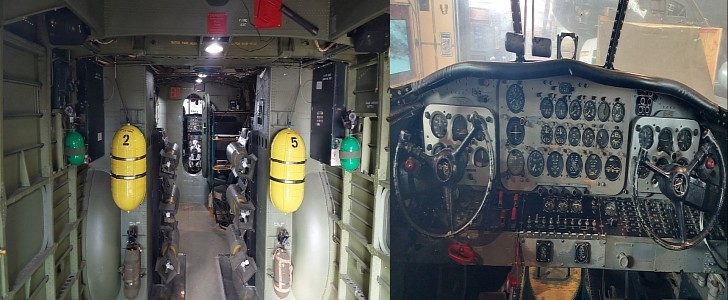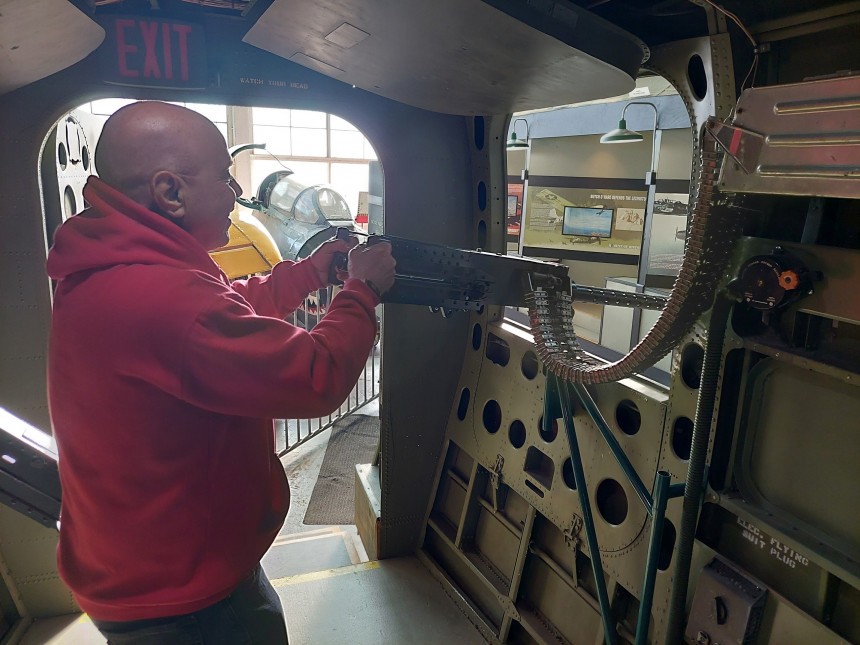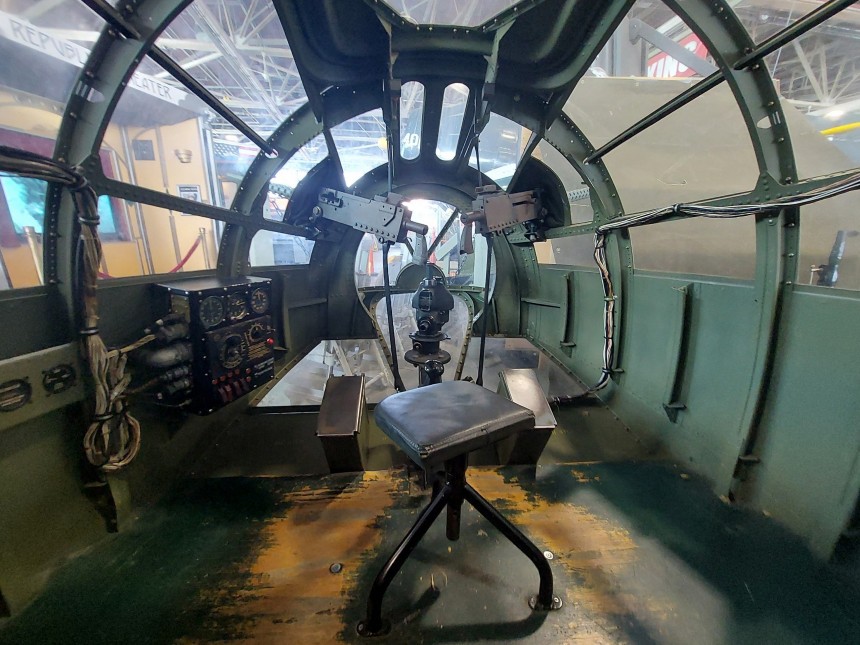Name any famous World War Two movie made after the mid-40s, and you can probably point out a shot of the inside a vintage military aircraft at some point or another.
Especially in the years since these planes have stopped serving, these scenes are often shot inside film studios, as some of the aircraft depicted are no longer available. But what does the inside of a Second World War-era military aircraft actually look like?
Well, who better to answer that question than the folks at one of the world's few living aircraft museums. Many of the two dozen or so aircraft on display at the American Airpower Museum in Farmingdale, New York, is in nearly flight-ready condition.
A handful have taken to the skies as early as a few months ago. But one exhibit on display in the main hangar that's more permanently fixed to the ground is an intact fuselage and cockpit of a Korean vintage Grumman Albatross.
The Grumman Albatross was a post World War II design from a manufacturer that produced its planes just down the road from Farmingdale in nearby Bethpage, New York. Making Long Island's Nassau County one of the largest hubs of aviation development in the world at one point.
An above-average-sized twin-engined seaplane, the Albatross was the largest in a line of Grumman-produced seaplanes like the Goose, Duck, and Mallard. At new, these planes sported Wright R-1820 cyclone radial nine-cylinder engines, but these have been removed along with the rest of the wings in this example.
What hasn't been removed is the variable treasure trove of genuine 40s and early 50s era military aviation technology. From the outside, this Albatross doesn't look all that special. We'll show you some pictures of what it would have looked like in the slideshow above if you're curious. But unlike most warplane exhibits, you can step inside the rear door and see for yourself what it's like inside.
Believe it or not, the first thing that strikes you when you take your first step into the crew compartment of this nearly 70-year-old aircraft isn't how it looks inside but how it smells. In the same way the interior of a brand-new car has a very distinct scent, so too does that canvas, fabric, and other interior pieces have their own distinctive aroma inside. This may be off-putting to some, but to us fanatics, it's as great as it gets.
Moving to the visuals of the interior, we can't help but think it would have been awfully cramped moving back and forth in this thing at cruising altitudes. Especially since the landing was more than likely to be on the water, it's a good thing none of us were given this task. It's also worth noting that there are pretty much zero soft-touch surfaces anywhere in the aircraft. Just bare metal, exposed O2 canisters, and lots and lots of sharp-edged to poke yourself or even rip your pants on.
Even in the cramped space, there's still plenty of room to move around inside. If you think that's strange in a World War Two strategic bomber, you're not wrong. That's because this wonderful teaching exhibit is a Grumman Albatross on the outside and a B-17 Flying Fortress on the inside. Museum staff here in Farmingdale figured it would be an overall better learning experience if patrons didn't need to crawl on their stomachs and squeeze past one another to see all the cool OEM B-17 gadgets on display.
Most aviation museums will throw you out on the streets if you get too touchy-feely with any of the exhibits, not so at the Airpower Museum. You get to squeeze into the pilot's seat, crawl into the front face defensive gunnery position, or the demilitarized M2 Browning machine gun waste-turrets. However, you'll have to donate to the museum to sit inside any of the fighters.
The defined tactile feel of the switches on the equipment in the cockpit and in the crew compartment feels so wonderfully different than the capacitive touch screens we're so mundanely used to these days. There's a definitive action behind every switch, every lever, and every piece of steel in this exhibit. It may not be 100% the real thing, but in this case, we don't think there'll be any complaints about that, especially for the many school-aged children who frequent them museum regularly.
Well, who better to answer that question than the folks at one of the world's few living aircraft museums. Many of the two dozen or so aircraft on display at the American Airpower Museum in Farmingdale, New York, is in nearly flight-ready condition.
A handful have taken to the skies as early as a few months ago. But one exhibit on display in the main hangar that's more permanently fixed to the ground is an intact fuselage and cockpit of a Korean vintage Grumman Albatross.
The Grumman Albatross was a post World War II design from a manufacturer that produced its planes just down the road from Farmingdale in nearby Bethpage, New York. Making Long Island's Nassau County one of the largest hubs of aviation development in the world at one point.
What hasn't been removed is the variable treasure trove of genuine 40s and early 50s era military aviation technology. From the outside, this Albatross doesn't look all that special. We'll show you some pictures of what it would have looked like in the slideshow above if you're curious. But unlike most warplane exhibits, you can step inside the rear door and see for yourself what it's like inside.
Believe it or not, the first thing that strikes you when you take your first step into the crew compartment of this nearly 70-year-old aircraft isn't how it looks inside but how it smells. In the same way the interior of a brand-new car has a very distinct scent, so too does that canvas, fabric, and other interior pieces have their own distinctive aroma inside. This may be off-putting to some, but to us fanatics, it's as great as it gets.
Moving to the visuals of the interior, we can't help but think it would have been awfully cramped moving back and forth in this thing at cruising altitudes. Especially since the landing was more than likely to be on the water, it's a good thing none of us were given this task. It's also worth noting that there are pretty much zero soft-touch surfaces anywhere in the aircraft. Just bare metal, exposed O2 canisters, and lots and lots of sharp-edged to poke yourself or even rip your pants on.
Most aviation museums will throw you out on the streets if you get too touchy-feely with any of the exhibits, not so at the Airpower Museum. You get to squeeze into the pilot's seat, crawl into the front face defensive gunnery position, or the demilitarized M2 Browning machine gun waste-turrets. However, you'll have to donate to the museum to sit inside any of the fighters.
The defined tactile feel of the switches on the equipment in the cockpit and in the crew compartment feels so wonderfully different than the capacitive touch screens we're so mundanely used to these days. There's a definitive action behind every switch, every lever, and every piece of steel in this exhibit. It may not be 100% the real thing, but in this case, we don't think there'll be any complaints about that, especially for the many school-aged children who frequent them museum regularly.





















